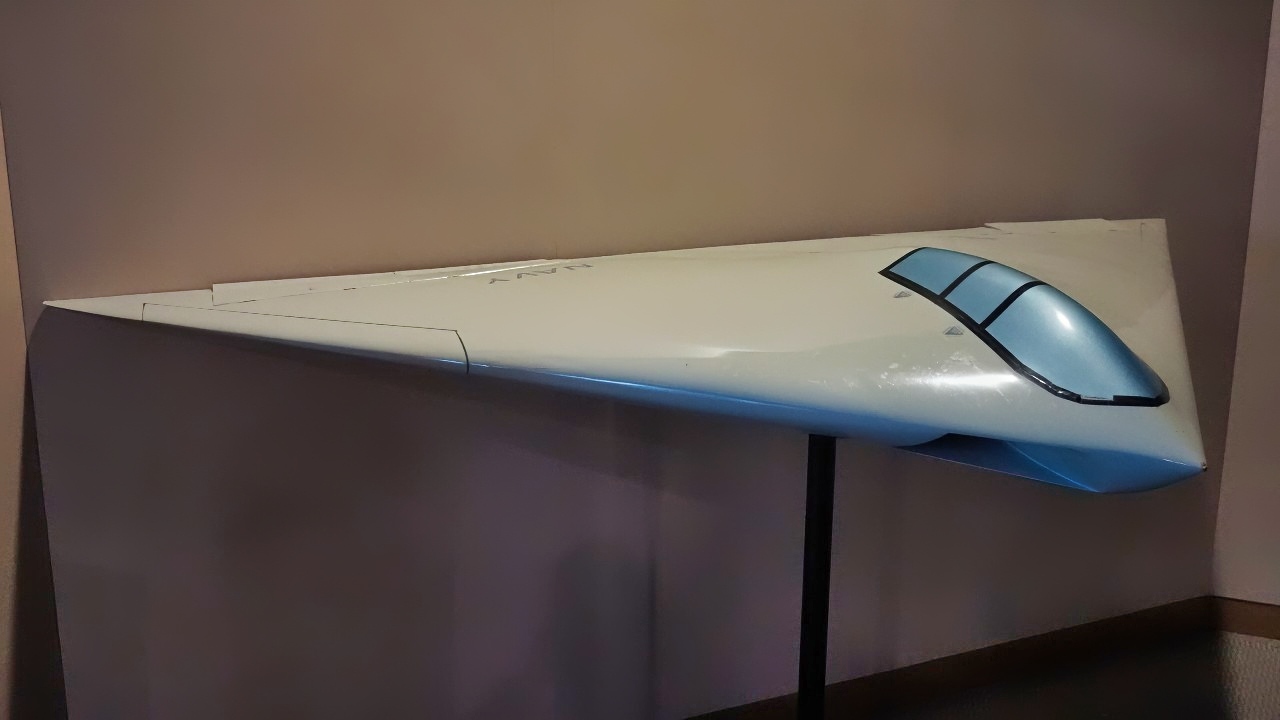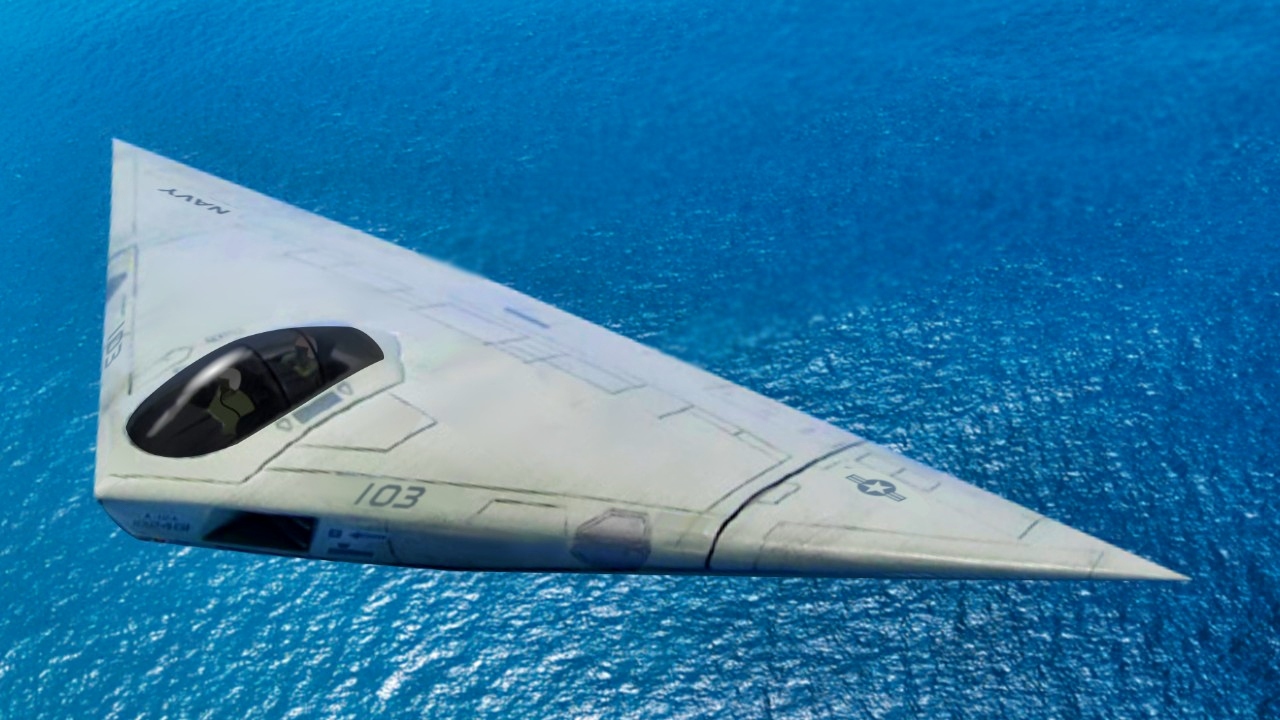Key Points and Summary – The General Dynamics/McDonnell Douglas A-12 Avenger II was an ambitious U.S. Navy stealth bomber program in the 1980s.
-Nicknamed the “Flying Dorito” for its unique triangular shape, it was designed as a carrier-based replacement for the A-6 Intruder.

A-12 Avenger II Model. Image Credit: Creative Commons.
-However, the program was plagued by severe technical challenges, massive cost overruns, and years of delays.
-Citing these failures, Secretary of Defense Dick Cheney canceled the project in 1991, making it the largest contract termination in DoD history and triggering a two-decade legal battle.
-The Navy ultimately relied on the F/A-18 Super Hornet instead.
The A-12 Avenger II ‘Flying Dorito’ Was an Epic Failure
The General Dynamics/McDonnell Douglas A-12 Avenger II was a proposed attack aircraft intended to be used by the U.S. Navy and U.S. Marine Corps. It was envisioned as a carrier-based stealth bomber capable of conducting precision strikes deep behind enemy lines.
Despite its interesting design, the project faced numerous difficulties, including cost overruns and delays, which raised doubts about the program’s feasibility.
The program was cancelled in 1991, leading to a long legal battle between the contractors and the DoD, which lasted until 2014.
The Advanced Tactical Aircraft Program
The origins of the A-12 trace back to the early 1980s, when the U.S. Navy began planning for the eventual replacement of the Grumman A-6 Intruder, a twin-engine, all-weather attack aircraft that had been in service since the 1960s.
The Navy’s goal was to develop a new aircraft that could operate from aircraft carriers, penetrate heavily defended airspace, and deliver precision-guided munitions under all weather conditions. This vision led to the launch of the Advanced Tactical Aircraft (ATA) program in 1983.
The ATA program was part of a broader shift in U.S. military strategy that emphasized stealth technology, which the Air Force’s F-117 Nighthawk had already demonstrated. The Navy sought a stealthy aircraft capable of evading radar detection, carrying a substantial payload, and operating effectively in the maritime environment.
In 1984, the Navy awarded initial concept development contracts to two industry teams: one led by McDonnell Douglas and General Dynamics, and the other by Northrop, Grumman, and Vought.
Design of the A-12 Avenger II
After several years of design work and evaluation, the Navy selected the McDonnell Douglas/General Dynamics team in January 1988 to proceed with full-scale development.
The aircraft was designated the A-12 Avenger II, a name that paid homage to the World War II-era Grumman TBF Avenger torpedo bomber.
The A-12’s design was striking and unconventional. It featured a flying wing configuration shaped like an isosceles triangle, which earned it the nickname “Flying Dorito.” This shape was chosen to minimize the aircraft’s radar cross-section and enhance its stealth capabilities.
The A-12 was powered by two General Electric F412-D5F2 non-afterburning turbofan engines, each producing approximately 13,000 pounds of thrust.
The aircraft would have a crew of two and was designed to carry its weapons internally to preserve its stealth profile. It was expected to be capable of delivering a wide range of ordnance, including air-to-air missiles, anti-radiation missiles, precision-guided bombs, and potentially even nuclear weapons.
The Navy initially planned to purchase 620 A-12s, while the Marine Corps expressed interest in acquiring 238 of them. The Air Force also considered a variant of the A-12 to replace its aging F-111 fleet, with a potential order of 400 aircraft.
Rough Skies Ahead
Despite the ambitious goals and high expectations, the A-12 program encountered severe difficulties quickly. The aircraft’s complex design and reliance on cutting-edge technologies led to significant technical challenges. The use of advanced composite materials, stealth coatings, and sophisticated avionics systems proved more difficult and costly than anticipated. As the program progressed, it became clear that the contractors were struggling to meet performance targets and stay within budget.
By the early 1990s, the A-12 program was billions of dollars over budget and years behind schedule. The first flight, initially scheduled for December 1990, was repeatedly delayed. The program’s escalating costs and lack of tangible progress drew increasing scrutiny from the Department of Defense and Congress.
Cancellation and Legal Battles
On January 7, 1991, Secretary of Defense Dick Cheney made the unprecedented decision to cancel the A-12 program. He cited the contractors’ failure to meet performance and cost expectations as the primary reasons for the termination.
At the time of cancellation, the government had already spent over $5 billion on the program, making it the largest contract termination in U.S. defense history.
The cancellation of the A-12 triggered a protracted legal battle between the U.S. government and the contractors, McDonnell Douglas and General Dynamics. The government sought to recover billions in payments, alleging that the contractors had misrepresented the program’s progress. The contractors, in turn, argued that the government had improperly terminated the contract. The legal dispute dragged on for more than two decades before a final settlement was reached in January 2014 in favor of the contractors.
How Not to Procure an Advanced Aircraft
While the A-12 program may have been poorly handled, a lot of the ideas behind the aircraft were sound in principle. Its stealth capabilities, long range, and payload capacity would have made it a formidable asset for deep strike missions, electronic warfare, and reconnaissance.
The aircraft was envisioned as a versatile platform capable of replacing multiple existing systems and operating in high-threat environments with minimal support. Unfortunately, most of these goals turned out to be too high to be realistically met.
In the absence of the A-12, the Navy turned to upgraded versions of existing aircraft to fill the gap. The F/A-18 Hornet and its successor, the F/A-18E/F Super Hornet, became the backbone of the Navy’s carrier-based strike force. While these aircraft lacked the stealth and range of the A-12, they were more affordable, reliable, and much easier to integrate into existing carrier operations.
About the Author: Isaac Seitz
Isaac Seitz, a Defense Columnist, graduated from Patrick Henry College’s Strategic Intelligence and National Security program. He has also studied Russian at Middlebury Language Schools and has worked as an intelligence Analyst in the private sector.
Hypersonic Weapons In-Depth
Russia’s Hypersonic Missiles Summed Up in 4 Words










